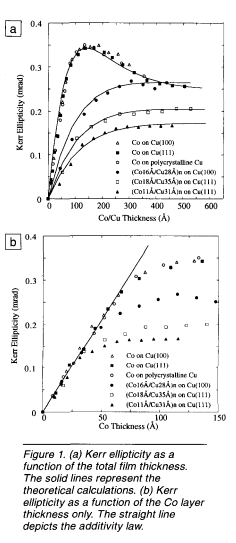Article contents
Surface Magnetism and Kerr Spectroscopy
Published online by Cambridge University Press: 29 November 2013
Extract
Magneto-optic effects were first discovered in 1845 by Michael Faraday, but these effects continue to make a major impact on the materials community to this day. The need for new magnetic information-storage media has stimulated new approaches and opened new scientific opportunities in the exploration of thin-film and surface magnetism. This article provides background to some of these developments and highlights examples of contemporary issues that provide a focus for the field. In the Faraday effect, the polarization plane of linearly polarized light rotates when a magnetic field is applied in the propagation direction. The analogous phenomenon was subsequently discovered by the Rev. John Kerr in 1877 for light reflected from opaque materials. The works of Faraday and Kerr serve as cornerstones for our present understanding of magneto-optic effects in magnetic materials. Magnetooptics is presently described in the context of either microscopic quantum theory or macroscopic dielectric theory. Microscopically, the coupling between the electric field of the propagating light and the electron spin in a magnetic medium occurs through the spin-orbit interaction. Macroscopically, magneto-optic effects arise from the antisymmetric, off-diagonal elements in the dielectric tensor, as discussed in the next section.
Magneto-optic characterizations of surface magnetism began only a decade ago. The first surface magneto-optic Kerr-effect study, better known by its acronym SMOKE, concerned the magnetichysteresis loops for ultrathin Fe films grown epitaxially on Au(100). Since then, SMOKE has emerged as a premier surface-magnetism technique. SMOKE has been applied to various topics in low-dimensional magnetism, ranging from the detection of magnetic order to the characterization of critical behavior, magnetic surface anisotropies, and the oscillatory antiferromagnetic coupling exhibited by giant-magnetoresistance

heterostructures. Additional interest in SMOKE has been generated by the recent commercialization of high-density, magneto-optic information-storage media, and especially by the next-generation candidate material based on Co/Pt superlattices.
- Type
- Magnetism on a Microscopic Scale
- Information
- Copyright
- Copyright © Materials Research Society 1995
References
- 3
- Cited by




